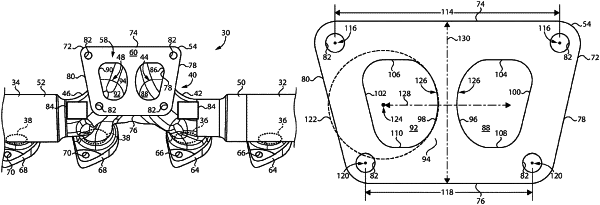| CPC F01N 13/105 (2013.01) [F02B 37/02 (2013.01); F02B 37/025 (2013.01); F02B 67/10 (2013.01); F01N 2260/10 (2013.01); F01N 2340/06 (2013.01); F05D 2220/40 (2013.01); F05D 2240/91 (2013.01)] | 18 Claims |

|
1. A turbine connector for an engine exhaust manifold comprising:
a turbine foot having an engine-facing side, and a turbine-mounting side defining a turbine-mounting plane;
the turbine foot further including an outer edge having a first perimetric base, a second perimetric base, a first perimetric leg and a second perimetric leg each extending between the first perimetric base and the second perimetric base;
the turbine foot further including a first inner edge forming a first exhaust outlet opening in the turbine-mounting side, a second inner edge forming a second exhaust outlet opening in the turbine-mounting side, and a web extending between the first exhaust outlet and the second exhaust outlet;
the first inner edge and the second inner edge each having a varied perimetric curvature that is largest in finite curvature size upon the web, and together forming an hourglass web profile in the turbine-mounting plane defining a first axis extending between the first perimetric leg and the second perimetric leg, and a second axis oriented normal to the first axis; and
the first inner edge and the second inner edge each having a curved segment upon the web, and a linear segment opposite to the respective curved segment, and each respective linear segment being oriented diagonally relative to both the first axis and the second axis.
|